Abstract
Multicellular tumor spheroids are widely used models in tumor research. Because of their three dimensional organization they can simulate avascular tumor areas comprising proliferative and necrotic cells. Nonetheless, protocols for spheroid generation are still inconsistent. Therefore, in this study the breast cancer cell lines MCF-7, MDA-MB-231 and SK-BR-3 have been used to compare different spheroid generation models including hanging drop, liquid overlay and suspension culture techniques, each under several conditions. Experimental approaches differed in cell numbers (400–10,000), media and additives (25 % methocel, 25 % methocel plus 1 % Matrigel, 3.5 % Matrigel). In total, 42 different experimental setups have been tested. Generation of spheroids was evaluated by light microscopy and the structural composition was assessed immunohistochemically by means of Ki-67, cleaved poly (ADP-ribose) polymerase (cPARP) and mucin-1 (MUC-1) expression. Although the tested cell lines diverged widely in their capacity of forming spheroids we recommend hanging drops supplemented with 25 % methocel as the most reliable and efficient method with regard to success of generation of uniform spheroids, costs, experimental complexity and time expenditure in the different cell lines. MCF-7 cells formed spheroids under almost all analyzed conditions, and MDA-MB-231 cells under only one protocol (liquid overlay technique, 3.5 % Matrigel), while SK-BR-3 did not under neither condition. Therefore, we outline specific methods and recommend the use of adapted and standardized spheroid generation protocols for each cell line.




Similar content being viewed by others
Abbreviations
- MCTS:
-
multicellular tumor spheroids
References
Leong DT, Ng KW. Probing the relevance of 3D cancer models in nanomedicine research. Adv Drug Deliv Rev. 2014;15:79–80 .p. 95–106
Mehta G et al. Opportunities and challenges for use of tumor spheroids as models to test drug delivery and efficacy. J Control Release. 2012;164(2):192–204.
Nederman T et al. Demonstration of an extracellular matrix in multicellular tumor spheroids. Cancer Res. 1984;44(7):3090–7.
Rotin D, Robinson B, Tannock IF. Influence of hypoxia and an acidic environment on the metabolism and viability of cultured cells: potential implications for cell death in tumors. Cancer Res. 1986;46(6):2821–6.
Nagelkerke A et al. Generation of multicellular tumor spheroids of breast cancer cells: how to go three-dimensional. Anal Biochem. 2013;437(1):17–9.
Kelm JM et al. Method for generation of homogeneous multicellular tumor spheroids applicable to a wide variety of cell types. Biotechnol Bioeng. 2003;83(2):173–80.
Carver K, Ming X, Juliano RL. Multicellular tumor spheroids as a model for assessing delivery of oligonucleotides in three dimensions. Mol Ther Nucleic Acids. 2014;3:e153.
Mellor HR, Ferguson DJ, Callaghan R. A model of quiescent tumour microregions for evaluating multicellular resistance to chemotherapeutic drugs. Br J Cancer. 2005;93(3):302–9.
Desoize, B. and J. Jardillier, Multicellular resistance: a paradigm for clinical resistance? Crit Rev Oncol Hematol, 2000. 36(2–3): p. 193–207.
Levenson AS, Jordan VC. MCF-7: the first hormone-responsive breast cancer cell line. Cancer Res. 1997;57(15):3071–8.
Trempe, GL. Human breast cancer in culture. Recent Results Cancer Res. 1976;57:33–41.
Cailleau R, Olive M, Cruciger QV. Long-term human breast carcinoma cell lines of metastatic origin: preliminary characterization. In Vitro. 1978;14(11):911–5.
Vinci M et al. Advances in establishment and analysis of three-dimensional tumor spheroid-based functional assays for target validation and drug evaluation. BMC Biol. 2012;10:29.
Korff T, Augustin HG. Integration of endothelial cells in multicellular spheroids prevents apoptosis and induces differentiation. J Cell Biol. 1998;143(5):1341–52.
Ivascu A, Kubbies M. Rapid generation of single-tumor spheroids for high-throughput cell function and toxicity analysis. J Biomol Screen. 2006;11(8):922–32.
Lupp A, Danz M, Muller D. Morphology and cytochrome P450 isoforms expression in precision-cut rat liver slices. Toxicology. 2001;161(1–2):53–66.
Charoen KM et al. Embedded multicellular spheroids as a biomimetic 3D cancer model for evaluating drug and drug-device combinations. Biomaterials. 2014;35(7):2264–71.
Costa EC et al. Optimization of liquid overlay technique to formulate heterogenic 3D co-cultures models. Biotechnol Bioeng. 2014;111(8):1672–85.
Metzger W et al. The liquid overlay technique is the key to formation of co-culture spheroids consisting of primary osteoblasts, fibroblasts and endothelial cells. Cytotherapy. 2011;13(8):1000–12.
Friedrich J et al. Spheroid-based drug screen: considerations and practical approach. Nat Protoc. 2009;4(3):309–24.
Breslin S, O'Driscoll L. Three-dimensional cell culture: the missing link in drug discovery. Drug Discov Today. 2013;18(5–6):240–9.
Hirschhaeuser F et al. Multicellular tumor spheroids: an underestimated tool is catching up again. J Biotechnol. 2010;148(1):3–15.
Timmins NE, Dietmair S, Nielsen LK. Hanging-drop multicellular spheroids as a model of tumour angiogenesis. Angiogenesis. 2004;7(2):97–103.
Sutherland RM et al. Oxygenation and differentiation in multicellular spheroids of human colon carcinoma. Cancer Res. 1986;46(10):5320–9.
Lin RZ, Chang HY. Recent advances in three-dimensional multicellular spheroid culture for biomedical research. Biotechnol J. 2008;3(9–10):1172–84.
Kunz-Schughart LA et al. The use of 3-D cultures for high-throughput screening: the multicellular spheroid model. J Biomol Screen. 2004;9(4):273–85.
Kim CH et al. Implication of snail in metabolic stress-induced necrosis. PLoS One. 2011;6(3):e18000.
Grimes DR et al. A method for estimating the oxygen consumption rate in multicellular tumour spheroids. J R Soc Interface. 2014;11(92):20131124.
Acknowledgments
The project is funded by the Wilhelm Sander Foundation (Germany). Karolin Fröhlich receives a Ph.D. grant from the Evangelic Scholarship Department Villigst (Germany). Stella Mary Photini had a Ph.D. grant from the German Academic Exchange Service (DAAD). The Placenta-Labor had grants from the Thuringian Ministry of Education, Science and Arts.
Author information
Authors and Affiliations
Corresponding author
Ethics declarations
Conflict of Interest Statement
All authors declare that they have no conflict of interest.
Rights and permissions
About this article
Cite this article
Froehlich, K., Haeger, JD., Heger, J. et al. Generation of Multicellular Breast Cancer Tumor Spheroids: Comparison of Different Protocols. J Mammary Gland Biol Neoplasia 21, 89–98 (2016). https://doi.org/10.1007/s10911-016-9359-2
Received:
Accepted:
Published:
Issue Date:
DOI: https://doi.org/10.1007/s10911-016-9359-2




